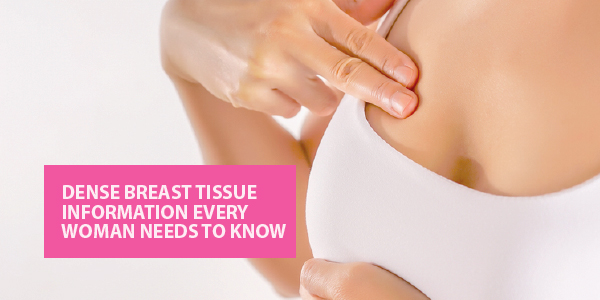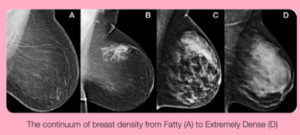TESTIMONIALS
"Everyone was great. Very fast and very convenient, thanks. Very professional. I will come back next year."

Oro Valley, AZ
"I will recommend this to my friends. Thank you so much for all you do. Thanks for making getting a mammogram so convenient."

Phoenix, AZ

Dense Breast Tissue Information Every Woman Needs to Know
Risk factors and answers for women with dense breast tissue:
- 40% of women who have a screening mammogram have dense breast tissue.
- The accuracy of mammographyis decreased in dense breast tissue.
- The American Cancer Society (ACS) now places the relative risk of breast cancer due to high tissue density at 4-6 times the normal risk.
3D Mammography, or Tomosynthesis breast imaging enables physicians to see masses and distortions more clearly. With this process, tomosynthesis obtains multiple images from a variety of angles through the entire breast. Even fine details become obvious because they’re no longer hidden by surrounding tissue as they would be with a 2D mammogram.
High-Risk Women’s FAQ
Hereditary breast and ovarian cancer syndrome (HBOC) is an adult-onset, cancer predisposition syndrome. HBOC is characterized by a high risk of breast and ovarian cancers, and an increased risk of other cancers such as male breast cancer, prostate, pancreatic and melanoma.
The name BRCA is the abbreviation for Breast Cancer gene. BRCA1 and BRCA2 are the two genes that are most important to fighting cancer. They are tumor suppressor genes, found in every human and is responsible for mitigating breast, ovarian, and other types of cells from growing and dividing too rapidly or in an otherwise uncontrolled way.
We recommend genetic counseling for HBOC for women who have strong personal or family history of breast and/or ovarian cancers. During this procedure, genetic counselors review your family history in depth and help you decide if testing for the BRCA gene is right for you.
Dense Breast Tissue - FAQ's
All breasts contain glands, fibrous tissue, and fat. Dense tissue is made of glands and fibrous tissue (referred to as “fibroglandular” tissue). Dense tissue blocks x-rays and therefore appears white on a mammogram. Fatty tissue allows more x-rays to penetrate and therefore shows up as black or dark gray on a mammogram. Each woman’s breasts contain a unique mix of fatty and dense tissue. Some women’s breasts are almost all fat, some have very little fat, and some are in-between. Dense breasts are normal and tend to become less dense with age and menopause.
Breast density is not determined by how a breast looks or feels. Dense breast tissue can only be identified through a mammogram. The radiologist determines the breast density by examining the images from your mammogram screening. Refer to the Mammography Result Notification Letter to learn about your breast density.
Dense breasts are “normal.” On average, about 40% of women of mammography age have dense breasts. However, because dense breast tissue can hide cancer on a mammogram, it may reduce the ability of your radiologist to find cancer if present. A “normal,” “negative,” or “benign” mammogram does not reliably exclude cancer in women with dense breasts.Women with dense breasts may have cancer detected soon after a “normal” or “negative” mammogram (this is known as an “interval cancer”). If your mammogram shows you have dense breasts, you should discuss additional screening options with your health care provider.
Absolutely! Talk to your referring physician about the other imaging options available including: 3D Mammography, Breast Ultrasound, and/or Breast MRI. Research suggests that adding more sensitive tests to mammography can significantly increase the detection of invasive cancers
Patient Wellness And Continuum Of Care Are Assured Imaging’s Main Focus
Both our mobile coaches and our fixed locations provide the latest in cutting-edge, proven technology.
- Assured Imaging offers both mobile digital 3D and 2D mammogram screenings.
- 1 in 8 women will be diagnosed with breast cancer.
- Women 40 and older should get a mammogram screening once every year.
- At age 35, women should get a baseline mammogram.
- Nearly all breast cancer is successfully treated if detected early!
1-888-233-6121
- BREAST FELLOWSHIP TRAINED RADIOLOGISTS
- LOW DOSE RADIATION
- IMPLANT SAFE

Dense Breast Tissue Information Every Woman Needs to Know
Risk factors and answers for women with dense breast tissue:
- 40% of women who have a screening mammogram have dense breast tissue.
- The accuracy of mammographyis decreased in dense breast tissue.
- The American Cancer Society (ACS) now places the relative risk of breast cancer due to high tissue density at 4-6 times the normal risk.
3D Mammography, or Tomosynthesis breast imaging enables physicians to see masses and distortions more clearly. With this process, tomosynthesis obtains multiple images from a variety of angles through the entire breast. Even fine details become obvious because they’re no longer hidden by surrounding tissue as they would be with a 2D mammogram.
High-Risk Women’s FAQ
Hereditary breast and ovarian cancer syndrome (HBOC) is an adult-onset, cancer predisposition syndrome. HBOC is characterized by a high risk of breast and ovarian cancers, and an increased risk of other cancers such as male breast cancer, prostate, pancreatic and melanoma.
The name BRCA is the abbreviation for Breast Cancer gene. BRCA1 and BRCA2 are the two genes that are most important to fighting cancer. They are tumor suppressor genes, found in every human and is responsible for mitigating breast, ovarian, and other types of cells from growing and dividing too rapidly or in an otherwise uncontrolled way.
We recommend genetic counseling for HBOC for women who have strong personal or family history of breast and/or ovarian cancers. During this procedure, genetic counselors review your family history in depth and help you decide if testing for the BRCA gene is right for you.
Dense Breast Tissue - FAQ's
All breasts contain glands, fibrous tissue, and fat. Dense tissue is made of glands and fibrous tissue (referred to as “fibroglandular” tissue). Dense tissue blocks x-rays and therefore appears white on a mammogram. Fatty tissue allows more x-rays to penetrate and therefore shows up as black or dark gray on a mammogram. Each woman’s breasts contain a unique mix of fatty and dense tissue. Some women’s breasts are almost all fat, some have very little fat, and some are in-between. Dense breasts are normal and tend to become less dense with age and menopause.
Breast density is not determined by how a breast looks or feels. Dense breast tissue can only be identified through a mammogram. The radiologist determines the breast density by examining the images from your mammogram screening. Refer to the Mammography Result Notification Letter to learn about your breast density.
Dense breasts are “normal.” On average, about 40% of women of mammography age have dense breasts. However, because dense breast tissue can hide cancer on a mammogram, it may reduce the ability of your radiologist to find cancer if present. A “normal,” “negative,” or “benign” mammogram does not reliably exclude cancer in women with dense breasts.Women with dense breasts may have cancer detected soon after a “normal” or “negative” mammogram (this is known as an “interval cancer”). If your mammogram shows you have dense breasts, you should discuss additional screening options with your health care provider.
Absolutely! Talk to your referring physician about the other imaging options available including: 3D Mammography, Breast Ultrasound, and/or Breast MRI. Research suggests that adding more sensitive tests to mammography can significantly increase the detection of invasive cancers
Patient Wellness And Continuum Of Care Are Assured Imaging’s Main Focus
Both our mobile coaches and our fixed locations provide the latest in cutting-edge, proven technology.
- Assured Imaging offers both mobile digital 3D and 2D mammogram screenings.
- 1 in 8 women will be diagnosed with breast cancer.
- Women 40 and older should get a mammogram screening once every year.
- At age 35, women should get a baseline mammogram.
- Nearly all breast cancer is successfully treated if detected early!
1-888-233-6121
- BREAST FELLOWSHIP TRAINED RADIOLOGISTS
- LOW DOSE RADIATION
- IMPLANT SAFE
LOCATIONS
Mammography / Breast Imaging Services are provided in:
Tucson, AZ
Scottsdale, AZ
Las Cruces, NM
Los Lunas, NM
Clovis, NM
TESTIMONIALS
"Everyone was great. Very fast and very convenient, thanks. Very professional. I will come back next year."

Oro Valley, AZ
"I will recommend this to my friends. Thank you so much for all you do. Thanks for making getting a mammogram so convenient."

Phoenix, AZ
ABOUT US
Assured Imaging is the leading provider of mobile digital mammography in the United States. Collectively, our presence includes 16 full modality centers across the Northeast, Southwest, and Western U.S. in addition to operating some 40 mobile imaging coaches and portable units focused on women’s wellness in 10 different states.
CONTACT US
Corporate Headquarters
7717 N Hartman Ln
Tucson, AZ 85743
Phone: (520) 744-6121
Toll Free (888) 233-6121
Fax: (520) 572-7138
BILLING INQUIRIES
Need to pay a bill?
Click the link below to begin
Assured Imaging is a subsidiary of Rezolut


